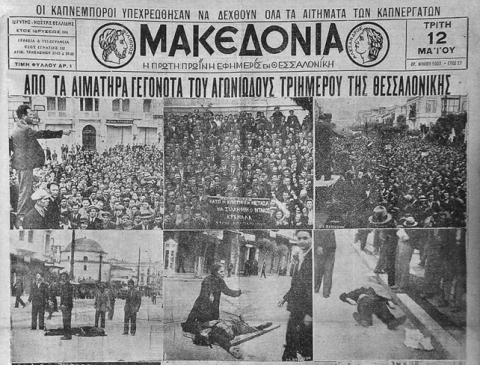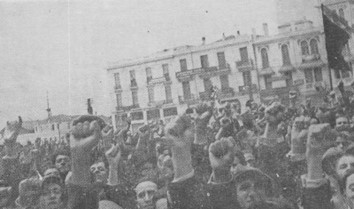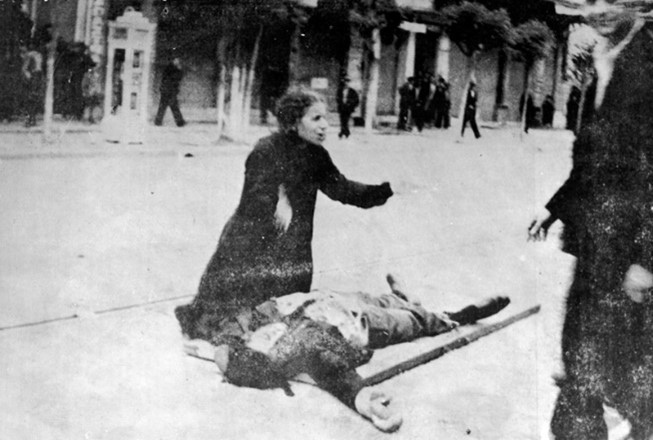Thessaloniki May 1936: A milestone in the history of the Greek worker’s movement

Thessaloniki, an industrial city with a multi-ethnic labour class was the “mother of the labour movement” in Greece with the foundation of the first mass socialist workers' union, the Federacion in 1909. The Federacion newspaper was published in 4 languages, Greek, Ladino (Judaeo-Spanish), Turkish and Bulgarian to unite the working class of the city. After 1922, Greece experienced a massive influx of 1.5 million refugees from Asia Minor, as a result of the failure of the imperialist strategy of the Greek bourgeoisie and British imperialism, the defeat of the military intervention in Asia Minor.
Greece was in the midst of militant upheavals from the beginning of the 30s. Employers used the refugees from Asia Minor to push down wages, unemployment soared, poverty and misery touched massive layers of the population. At the same time, the repression of any struggle was very harsh. The crash of 1929 in the world economy, which began to affect Greece from 1931, made things even worse.
Large-scale strikes gradually took the characteristics of peoples' revolts. The center of the revolt was Thessaloniki where strikes in various sectors had been erupting. On April 29, 1936 the tobacco workers declared a strike demanding, among other things, the establishment of an eight-hour work day and better wages. Their mobilizations created a wave of solidarity across Greece. Until May the 1st 1936, the strikes had spread in other cities in Greece.
On May 8, 1936 the strike and rally of tobacco workers in Thessaloniki was unprecedented with the participation of thousands of workers. On May 9th the General Confederation of Greek Workers declared a 24-hour strike. The rally in Thessaloniki turned into into a mass uprising against the political establishment, while the government transformed the city into a military camp. The police, aided by the army which had been sent in an equestrian force and a motorized unit, confronted the massive strike by opening fire on the protesters. leaving 12 dead and 32 seriously wounded demonstrators.
The deadly attacks couldn't stop the demonstration, while a number of soldiers denied to shoot and joined the workers. The slogan “down with fascism” spread in the city. On the next day, the funerals of the workers were attended by more than 200,000 people (in a city of half a million people at that time). Armed forces, disembarked at Thessaloniki's port, tried to enforce law and order in the city. The people were demonstrating outside the police stations demanding punishment for the murderers and threatening to lynch those who led the massacre of the workers. By order of the commander of the Army Corps, the gendarmes were confined to the police stations. In fact, they had been corralled by the anger of the people, who found themselves for 36 hours the masters of the city, as the bourgeois state could not exercise its power.
The Communist Party did not manage to take advantage of this revolutionary situation in Thessaloniki in those days. The workers were angry and powerful and had won the support of the whole society, the army was divided because many soldiers were fraternizing with the demonstrators and the army leadership could not move decisively. The atmosphere was explosive in every respect.
The Communist Party (KKE) maintained a compromising attitude throughout the uprising. This was the result of the policy of "popular fronts", adopted by the leadership of the KKE. This policy meant that the KKE would seek alliances with bourgeois parties. What the Communist Party did not understand was that despite the differences between the bourgeoisie - liberals and conservatives - they would prefer in the end to unite against the workers.
 The uprising in Thessaloniki galvanized the labor movement in Greece. The strike in Thessaloniki was over on May 11, after the demands of the strikers were satisfied. On May 13th another nationwide strike took place demanding a state system of pensions and medical coverage. Under the pressure of the strikes the government hypocritically declared that all of the workers' demands would be pleased- something that never happened. The Greek bourgeoisie, the Royal family and their imperialist collaborators had different plans. The brutality of the police during the strike has remained legendary, revealing the means that the liberal state is willing to use in order to remain in power.
The uprising in Thessaloniki galvanized the labor movement in Greece. The strike in Thessaloniki was over on May 11, after the demands of the strikers were satisfied. On May 13th another nationwide strike took place demanding a state system of pensions and medical coverage. Under the pressure of the strikes the government hypocritically declared that all of the workers' demands would be pleased- something that never happened. The Greek bourgeoisie, the Royal family and their imperialist collaborators had different plans. The brutality of the police during the strike has remained legendary, revealing the means that the liberal state is willing to use in order to remain in power.
What followed is known as “Metaxas Regime”. On August 4th 1936, Prime Minister Metaxas with the support of King George and the British imperialism initiated a coup dissolving the bourgeois parliament and establishing an authoritarian dictatorship which ruled Greece until the Nazi Occupation in 1941. Thousands of trade unionists and communists were persecuted, imprisoned and exiled.
 The first dead worker in Thessaloniki was Tasos Tousis. His comrades placed his lifeless body on a door they had ripped from a nearby building. His mother found him on that point. The shocking photo of her son's mourning was published and became the inspiration for the communist poet Yannis Ritsos to write his epic and best known poem “Epitaphios”. In 1958, Ritsos sent “Epitaphios” to copmposer Mikis Theodorakis. As a musical setting for the poem, Theodorakis followed Ritsos's lead and blended folk themes to produce a lament song.
The first dead worker in Thessaloniki was Tasos Tousis. His comrades placed his lifeless body on a door they had ripped from a nearby building. His mother found him on that point. The shocking photo of her son's mourning was published and became the inspiration for the communist poet Yannis Ritsos to write his epic and best known poem “Epitaphios”. In 1958, Ritsos sent “Epitaphios” to copmposer Mikis Theodorakis. As a musical setting for the poem, Theodorakis followed Ritsos's lead and blended folk themes to produce a lament song.
Like all of Theodorakis's work “Epitaphios” was banned from being publicly performed on and off until 1974, but the song circulated clandestinely.
Below, a small part of “Epitaphios” poem by Giannis Ritsos, translated in English:
On a day in May you left me, on that May day I lost you,
in springtime you loved so well, my son, when you went upstairs,
To the sun-drenched roof and looked out and your eyes never had their fill of drinking
in the light of the whole wide world at large.
With your manly voice so sweet and so warm, you recounted
as many things as all the pebbles strewn along the seashore.
My son, you told me that all these wonderful things will be ours,
but now your light has died out, our brightness and fire are gone.
Epitaphios-On a day in May you left me, music by Mikis Theodorakis, lyrics by Υannis Ritsos, song by Grigoris Bithikotsis: https://youtu.be/ZSDVBk0pT-M



















































